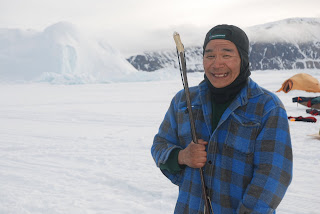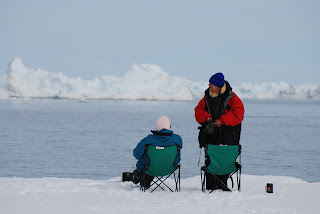
In the Arctic, for one month only, temperatures rise above freezing for an extended period of time. The land is bound in sea ice for 9 months of the year. The sun sets in October and rises again in February. Winter temperatures can plunge to —40° C and can stay for days. Storms are frequent. 40 mammals call the Arctic home, and half of these are sea mammals. Although 100 species of birds breed in the Arctic, only 10 live here year round.
Traditionally, the Inuit have lived in balance with their prey. If hunts were too successful, the animals declined and the people starved and died until balance between hunter and prey was redressed. Animals gave them everything they needed to survive as the land only offered sod, stone, ice and snow. The population of many hamlets on Baffin Island for example have stayed more or less the same for the past 4 thousand years.
By April this frozen landscape is bathed in 24 hour sunlight and within a month Thick-billed Murres, Black-legged Kittiwakes, Northern Fulmars, King Eider, Gyr and Peregrine Falcons to name a few will return to this land to breed. Narwhal, Bowhead, Atlantic Walrus swim the waters at the ice edge while Ring and Bearded seal sun themselves on the pack ice near their breathing holes. Polar bear tracks litter the pack ice. By mid May you can truly appreciate why the Arctic is called the beautiful land.

This spring we traveled to the Baffin Floe Edge. When we first arrived, we were greeted by the midnight sun glistening over the pack ice back dropped by the cliffs of Bylot Island. Glaucous gulls shrilled out across the quiet landscape while kids played in town and young mothers carried their babes in colourful amultees. We left the next day with 2 Inuit guides, Tommy and elder James along with James's grandson Tommy. We travel by sled to the floe edge where we set up a base camp which would become our home for the next 8 days. After anchoring our tents and collecting ice for our water, we stood and looked out across the land . There was a dark purple sky to the east where the open water lies. It is very quiet here. One of our Inuk guides, Tommy, says he loves this land. He likes the cool fresh air. He then speaks of the shipping traffic that is starting to come through here in the summer to bring supplies to the new lead zinc mine opening up and how the noise from the ships scare the narwhal away. He spoke how he traveled to their traditional caribou hunting grounds near this new lead zinc construction...”we drove 8 hours by ski doo to get there and we only caught one caribou. We tell the mining company every chance we have that their mining activity is scaring away the caribou, scaring the narwhal away. But they don’t care” he concludes angrily. When I suggest they speak up to other government organisations, he replies “We do”. Tommy then looks across his beautiful land and says “Whose land is it anyway? We’re just numbers. I love this land”.

The next day we wake to a glorious sunny morning and travel along the floe edge. We meet three locals camped next to the water where they are hoping to see narwhal. Polar bear tracks run right through their camp. Thick-billed Murres and Black Guillemots flock in great numbers. Further along the ice edge James spots a female polar bear with two cubs. We watch through binoculars how the mother has to spread her hind legs to keep from falling through the thin ice, while the cubs bounce along behind her without a care in the world. An hour later we see a male polar bear. Returning to camp we are lucky to witness a pair of Peregrine Falcons stoop a Black-legged Kittiwake in mid flight. We are able to sneak up behind some ice to try to photograph and watch the one Peregrine Falcon feeding while the other waited it’s turn a 100 meters off.

Late one night I hear Tommy call my name outside my tent. “Jane, Jane....there is a bear about a kilometer out feeding on a seal.” I hear the snow falling outside and I find it hard to find the will to get out of my warm sleeping bag. I haul on my boots and climb outside to see the bear. There is another hunter approaching it, and we see the bear start to run away. Suddenly the bear stops and turns around, heading back toward the hunter. We then see the bear disappear, as though it fell through a lead in the ice. We later hear that an ice berg had blocked the view of the bear from the hunter and when the hunter came around the berg, he wondered where the bear was.

He had stopped close to the bear who had decided to hide in the seal lair from the seal he had just hunted, which laid out on the pack ice. The bear then realised it was not the best hiding place, and from afar through our binoculars we watched the bear resurface on the pack ice, and walk over to the ice berg which he climbed and proceeded to hang out, snoozing, shaking his head, looking around....waiting for the human disturbance to go away. It was another perfect opportunity for us to watch bear behaviour as he rested on top of walls of blue ice, snorting, clicking his teeth in warning...his black nose snorting again and again. We stood above the seal lair and checked out the bear teeth marks on the seal. Back in camp, James was trying to train his dog, pointing out to the bear saying “nanook.....nanook” while his dog only looked at him, tail wagging, howling to the word ‘ nanook”. It made us all laugh.
We enjoyed traveling along the steep dolomite cliffs on the east side of Baffin Island to Cape Graham Moore where as many as 320,000 thick-billed murres and 50,000 black-legged kittiwakes utilize these cliffs. Other birds we see this trip include Greater Snow Goose, King Eider, Long-tailed Jaeger, Long-tailed Duck and Northern Fulmars. We visited many Thule sites, some many hundred years old. James tells us about his family life growing up in a sod house near Guys
Bight. He recounted a story when his mother was giving birth in the sod house, she commanded the kids hide under the blankets and wait until it was all over. “It was so hot under those blankets, I was sweating. And then when I heard the baby cry, I was afraid to come out from under them”. We also heard how James, as a young boy, wanted to drive his dog team to Pond Inlet, but he was too shy to arrive into the ‘big town’. So he tied up his dogs and rode in with another hunter.

We end our journey traveling back to Pond Inlet over the pack ice, oftentimes scoured by wind the bare ice was too slippery to walk on. Pools of water formed on top of the ice and leads opened up looked like rivers. We found a warm sunny place out of the wind behind a cliff to have a hot lunch when we saw a Raven’s nest. Raven chicks hatch in March, well ahead of other nesting birds up here. When we arrived into Pond, the purple saxifrage were blooming, a large dark solitary bee ‘ Bombus Polaris’ zigzagged crazily amongst the newly open flowers. Snowbuntings sung and flited from their nest hidden in the boulders. A pair of snow geese flew overhead. Spring arrived here in the North.
We will board our plane early next moring. It is always hard to leave Nuriassiq—the beautiful land.
 We end our journey traveling back to Pond Inlet over the pack ice, oftentimes scoured by wind the bare ice was too slippery to walk on. Pools of water formed on top of the ice and leads opened up looked like rivers. We found a warm sunny place out of the wind behind a cliff to have a hot lunch when we saw a Raven’s nest. Raven chicks hatch in March, well ahead of other nesting birds up here. When we arrived into Pond, the purple saxifrage were blooming, a large dark solitary bee ‘ Bombus Polaris’ zigzagged crazily amongst the newly open flowers. Snowbuntings sung and flited from their nest hidden in the boulders. A pair of snow geese flew overhead. Spring arrived here in the North.
We end our journey traveling back to Pond Inlet over the pack ice, oftentimes scoured by wind the bare ice was too slippery to walk on. Pools of water formed on top of the ice and leads opened up looked like rivers. We found a warm sunny place out of the wind behind a cliff to have a hot lunch when we saw a Raven’s nest. Raven chicks hatch in March, well ahead of other nesting birds up here. When we arrived into Pond, the purple saxifrage were blooming, a large dark solitary bee ‘ Bombus Polaris’ zigzagged crazily amongst the newly open flowers. Snowbuntings sung and flited from their nest hidden in the boulders. A pair of snow geese flew overhead. Spring arrived here in the North. 

